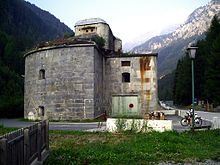Gomagoi roadblock
The Gomagoi road block , built in 1860/62, was located above the village of the same name at the confluence of the Trafoital in the Suldental and had the important task of blocking the road from the Stilfser Joch into the Vinschgau and over the Reschenpass into the Inn Valley . It was part of the overall system of the Austrian defense system on the border with Italy .
It was a roadblock in the true sense of the word, as the system was placed directly on Reichsstraße. In order to pass the barrier (southwards) one had to pass through the inner gate, past a guard casemate , through the outer gate and then over between the right flank of the plant and the retaining wall of the steep slope of the Obergrimm ridge that began here about four meters away a drawbridge . Already hopelessly out of date at the beginning of the First World War (the walls are made of stone), the barrier was nevertheless placed in defense readiness in 1914.
War occupation
- Détachements of the state rifle regiments Trento No. I and Innichen No. III
- 1 reserve company of the fortress artillery battalion No. 4 ( Riva )
- 1 Department of the fortress artillery battalion No. 7 (Malé / Val di Sole )
Armament
- 6 casemate cannons 9 cm
- 1 casemate cannon 8 cm
- 5 machine guns behind armor plates
- Supporting field fortifications were added
- Battery Taufers (4 cannons 9 cm)
- Battery Kleinboden (2 cannons 9 cm)
- Battery Goldsee (2 mortars 15 cm)
- Battery Schafseck (2 cannons 9 cm / 2 cannons 8 cm)
- Cavern battery Steinadler (2 casemate cannons 8 cm from Nauders )
In June 1915 a small Austrian détachement made up of gendarmerie assistants , finance guards, landstürmern and riflemen in platoon strength under the orders of the Kaiserjäger captain Andreas Steiner conquered Monte Scorluzzo (3,094 m) in Italian territory in a lightning operation .
Since this mountain completely dominates the Stilfser Joch and remained in Austrian hands until the end of the war, there was no fighting at the Gomagoi plant.
Actually, the work remained undamaged if the entire middle section had not been broken through later to lead the street (today's State Road 38) through. The factory serves as a warehouse and cannot be visited.
annotation
The number of guns integrated here indicates the importance of this lock. Overcoming the Stilfser Joch would have had unforeseeable consequences. The only thing that would have stood in the way of the Italians' advance to Innsbruck was the even older Nauders roadblock . Otherwise there was nothing left, no fortifications and certainly no troops. The consequences would have been incalculable, since it would have resulted in the collapse of the entire Austrian front west of the Brenner Pass .
literature
- Moritz Erwin von Lemwohl : The King of the German Alps and his heroes. Ortlerkampf 1915-1918 . Supplemented by historical articles edited by Helmut Golowitsch. Verlag Buchdienst Südtirol, Nuremberg 2005, ISBN 3-923995-28-8 .
- Erwin Anton Grestenberger: Imperial and Royal fortifications in Tyrol and Carinthia 1860–1918 . Verlag Österreich ua, Vienna 2000, ISBN 3-8132-0747-1 .
- Rolf Hentzschel: Austrian mountain fortresses in the First World War. The Folgeria and Lavarone plateaus . Athesia, Bozen 1999, ISBN 88-8266-019-2 , ( Athesia workshop. Non-fiction book ).
- Wilhelm Nussstein: Dolomites. Austrian fortresses in Northern Italy. From the seven municipalities to the Flitscher Klause . Mittler, Hamburg et al. 1997, ISBN 3-8132-0496-0 , ( military history travel guide ).
- CH Baer The fights for Tyrol and Carinthia - 11th volume Verlag Hoffmann, Stuttgart 1917
Web links
Coordinates: 46 ° 34 ′ 29 ″ N , 10 ° 32 ′ 20 ″ E

